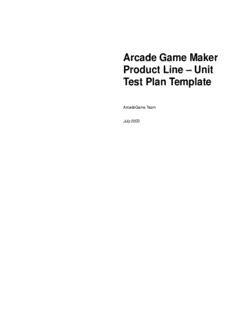
Arcade Game Maker Product Line – Unit Test Plan Template PDF
Preview Arcade Game Maker Product Line – Unit Test Plan Template
Arcade Game Maker Product Line – Unit Test Plan Template ArcadeGame Team July 2003 Table of Contents 1 Overview 1 1.1 Identification 1 1.2 Document Map 1 1.3 Concepts 2 1.4 Readership 2 2 Template Plan 3 3 Analyses and Standards 5 3.1 Coverage Standards 5 3.1.1 Functional 5 3.1.2 Structural 5 3.2 Analyses 5 3.2.1 Test suite construction 5 3.2.2 Incremental test analyses 5 3.2.2.1 Change Impact Analysis 6 3.2.2.2 Diff 6 4 Modifying the Unit Test Plan 7 4.1 Test effectiveness 8 5 References and Further Reading 9 Revision Control Table Revision Type A- Version Date Add, D- Description Person Number Revised Delete, of Change Responsible M- Modify CMU/SEI-2001-TR-001 i Responding V2.0 6/1/04 M to review JDMcGregor comments ii CMU/SEI-2001TR-001 1 Overview 1.1 Identification The Arcade Game Maker Product Line organization will produce a series of arcade games ranging from low obstacle count to high with a range of interaction effects. More detailed information can be found in the Arcade Game Maker scope document. This document describes how individual code assets are tested in the AGM product line. 1.2 Document Map The Arcade Game Maker Product Line is described in a series of documents. These documents are related to each other as shown in Figure 1. This map shows the order in which the documents should be read for the first time. Once the reader is familiar with the documents, the reader can go directly to the information needed. This is the unit test plan template. Product Line organizations use this document to capture how each code unit is tested. This document follows the outline provided in [McGregor 01b]. 1 Figure 1- Document Map 1.3 Concepts For definitions of basic concepts see the Glossary document. 1.4 Readership This document is intended to provide some level of information to all of the stakeholders in the Arcade Game Maker framework but is primarily intended for core asset development teams. The unit test plan describes for a manager the resources that are needed to test an asset. Technical members of the organization can use the unit test plan template as the guide for developing a complete unit-specific test plan. 2 CMU/SEI-2001-TR-001 2 Template Plan The AGM product line organization has decided to follow the IEEE 829 standard for test plans. The following template is filled in for each unit. See [McGregor 01b] for definitions of each section. 1. Introduction 2. Test Items 3. Tested Features Increment Functionality Schedule 1 2 3 4. Features Not Tested (per cycle) 5. Testing Strategy and Approach 5.1 Syntax 5.2 Description of Functionality 5.3 Arguments for tests 5.4 Expected Output 5.5 Specific Exclusions 5.6 Dependencies 5.7 Test Case Success/Failure Criteria 6. Pass/Fail Criteria for the Complete Test Cycle 7. Entrance Criteria/Exit Criteria The unit test phase runs concurrently with the unit development phase. The construction of test cases begins while the specification of the unit is being developed. Feedback from test case development allows the developer to see inconsistencies and ambiguities in the specification and to correct these. The unit test phase is exited when the developer has implemented the required unit and it has passed all of the tests required by the standards defined in the test plan template. 3 8. Test Suspension Criteria and Resumption Requirements Unit tests are suspended for one of two reasons: 1. the available functionality has been adequately tested and passed those tests but additional functionality remains to be developed, or 2. the available functionality has not passed the tests and the developer has sufficient information to make another development pass. Tests are resumed when the developer has constructed additional functionality of revised the existing functionality. 9. Test Deliverables/Status Communications Vehicles 10. Testing Tasks 11. Hardware and Software Requirements No special hardware is required for the tests of this cluster. The DotUnit executable and the accompanying framework classes are required for building test classes. 12. Problem Determination and Correction Responsibilities The developer has responsibility for corrections. The users of the cluster are responsible for reporting any problems to the listed owner of the cluster. 13. Staffing and Training Needs/Assignments 14. Test Schedules Increment Functionality Schedule 15. Risks and Contingencies 4 CMU/SEI-2001-TR-001 3 Analyses and Standards In this section we describe the techniques and the agreed-upon standards used to test each code asset in the AGM product line. These are justified and put into context in [McGregor 01b]. 3.1 Coverage Standards 3.1.1 Functional For each service on a component, a test case is constructed for every clause of the post- condition. Test the unit invariant before and after each service invocation. This can be done in conjunction with the service test cases. 3.1.2 Structural A test case is constructed for each sequence of statements. This effort can be optimized by first executing the functional tests with a code coverage tool running. Then only construct test cases to cover sequences of statements that were not covered by the functional test cases. Be certain that this includes all exceptional sequences. 3.2 Analyses 3.2.1 Test suite construction The AGM product line organization has decided to use the test case selection techniques described in [McGregor 01b]. Read that information before constructing test suites. 3.2.2 Incremental test analyses After the initial test suites have been created, different techniques are used to maintain the test suites. Every time the unit is changed, apply these techniques. 5 3.2.2.1 Change Impact Analysis Use the results from the Change Impact Analysis that was conducted by the developers. That analysis will have identified those portions of the asset that will be modified when the change is implemented. 3.2.2.2 Diff A tool such as diff can be used to show exactly what the difference is between two versions of the unit. Then tests can be modified to address just those differences. 6 CMU/SEI-2001-TR-001
Description: